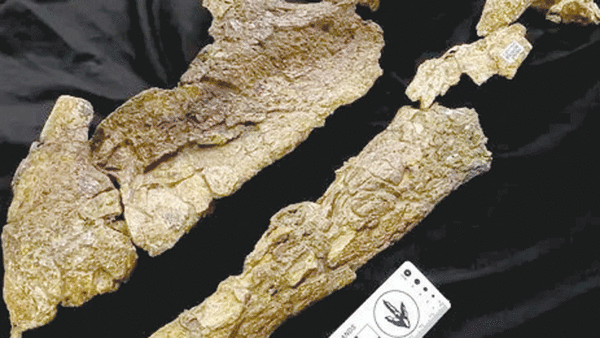

Researchers on Wednesday confirmed the discovery in the Queensland outback of the most complete skull of an “enormous sauropod” in Australia.
The finding, published in Royal Society Open Science on Wednesday and completed in collaboration with the Australian Age of Dinosaurs Museum of Natural History, supports a theory that sauropods were travelling between South America and Australia via Antarctica during the mid-Cretaceous period.
The near-complete skull, belonging to dinosaur nicknamed Ann and excavated in 2018 at Elderslie Station in Queensland, was identified as belonging to the Diamantinasaurus matildae species, a member of the dinosaur group Sauropoda known for having small heads, long necks and tails, barrel-like bodies and columnar legs.
The fossilised skull fragments date to 98-95 million years ago.
Lead researcher Dr Stephen Poropat from Curtin’s School of Earth and Planetary Sciences said Ann is the first sauropod dinosaur found in Australia to include most of the skull.
“This skull gives us a rare glimpse into the anatomy of this enormous sauropod that lived in northeast Australia almost 100 million years ago,” Poropat said in a Curtin University release.
“In analysing the remains, we found similarities between the Annskull and the skull of a titanosaur called ‘Sarmientosaurusmusacchioi,’ which lived in South America at about the same time as’ Diamantinasaurus’ lived in Queensland.
“These similarities include details of the braincase, the bones forming the back end of the skull near the jaw joint and the shape of the teeth.”
Poropat said that the finding supports a theory that sauropods were travelling between South America and Australia via Antarctica between 100 and 95 million years ago.
“The window between 100 and 95 million years ago was one of the warmest in Earth’s geologically recent history, meaning that Antarctica, which was more or less where it is now, had no ice,” Poropat said.
“Similarly, Australia, which was much further south than today, was warmer with less seasonality. In that climate, Antarctica was forested, and might have been an attractive habitat or pathway for wandering sauropods.” — dpa
Oman Observer is now on the WhatsApp channel. Click here


